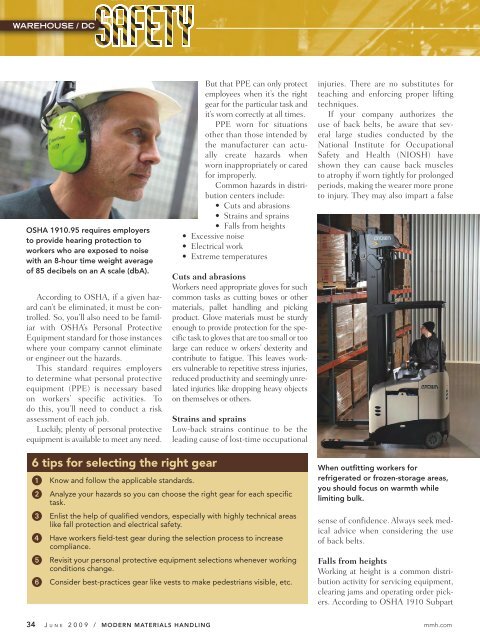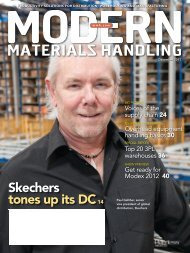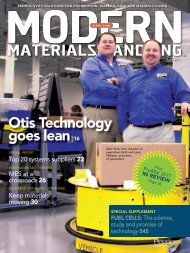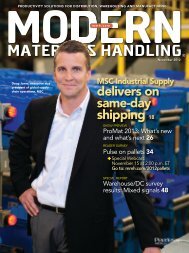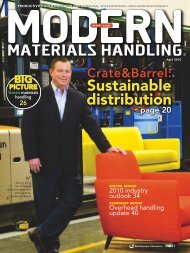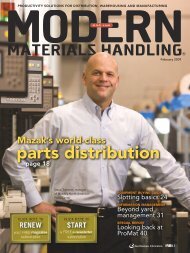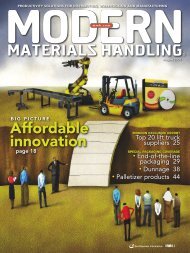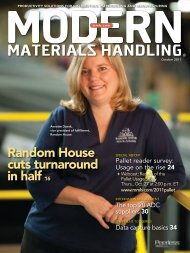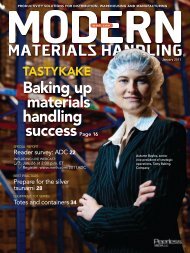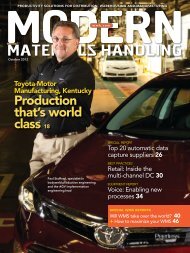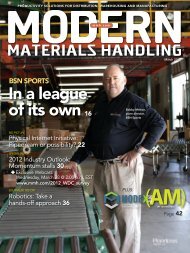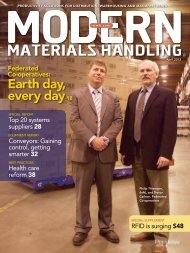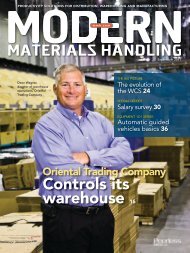WAREHOUSE / DCOSHA 1910.95 requires employersto provide hearing protection toworkers who are exposed to noisewith an 8-hour time weight averageof 85 decibels on an A scale (dbA).According to OSHA, if a given hazardcan’t be eliminated, it must be controlled.So, you’ll also need to be familiarwith OSHA’s Personal ProtectiveEquipment standard for those instanceswhere your company cannot eliminateor engineer out the hazards.This standard requires employersto determine what personal protectiveequipment (PPE) is necessary basedon workers’ specific activities. Todo this, you’ll need to conduct a riskassessment of each job.Luckily, plenty of personal protectiveequipment is available to meet any need.But that PPE can only protectemployees when it’s the rightgear for the particular task andit’s worn correctly at all times.PPE worn for situationsother than those intended bythe manufacturer can actuallycreate hazards whenworn inappropriately or caredfor improperly.Common hazards in distributioncenters include:• Cuts and abrasions• Strains and sprains• Falls from heights• Excessive noise• Electrical work• Extreme temperaturesCuts and abrasionsWorkers need appropriate gloves for suchcommon tasks as cutting boxes or othermaterials, pallet handling and pickingproduct. Glove materials must be sturdyenough to provide protection for the specifictask to gloves that are too small or toolarge can reduce w orkers’ dexterity andcontribute to fatigue. This leaves workersvulnerable to repetitive stress injuries,reduced productivity and seemingly unrelatedinjuries like dropping heavy objectson themselves or others.Strains and sprainsLow-back strains continue to be theleading cause of lost-time occupationalinjuries. There are no substitutes forteaching and enforcing proper liftingtechniques.If your company authorizes theuse of back belts, be aware that severallarge studies conducted by theNational Institute for OccupationalSafety and Health (NIOSH) haveshown they can cause back musclesto atrophy if worn tightly for prolongedperiods, making the wearer more proneto injury. They may also impart a false6 tips for selecting the right gear Know and follow the applicable standards. Analyze your hazards so you can choose the right gear for each specifictask. Enlist the help of qualified vendors, especially with highly technical areaslike fall protection and electrical safety. Have workers field-test gear during the selection process to increasecompliance. Revisit your personal protective equipment selections whenever workingconditions change. Consider best-practices gear like vests to make pedestrians visible, etc.When outfitting workers forrefrigerated or frozen-storage areas,you should focus on warmth whilelimiting bulk.sense of confidence. Always seek medicaladvice when considering the useof back belts.Falls from heightsWorking at height is a common distributionactivity for servicing equipment,clearing jams and operating order pickers.According to OSHA 1910 Subpart34 J UNE 2009 / MODERN MATERIALS HANDLING mmh.com
modern SAFETY TIPSD, Walking-Working Surfaces, fall protectionis required whenever workersconduct activities 4 feet or more abovethe working surface. When identifyingthe need for fall protection, alwaysinclude employee position in your calculations:the 42-inch top rail that isadequate for employees working onthe floor becomes inadequate whenemployees are working on a stepstool inthat area.Be sure you understand the requirementsin OSHA 1915.159, PersonalFall Arrest Systems, before you selector install fall-arrest equipment like lanyards,body harnesses (consider flexibleharnesses, if possible) and approvedtie-off points (temporary, permanentor lifeline). Consider using retractablelanyards, which are designed to engagequickly to limit fall distance, comparedto lanyards that engage at a predeterminedlength. When used properly,retractable lanyards can reduce traumato the body and force to the tie-off pointduring a fall.Foot protection in extreme working conditionsACCORDING TO THE NATIONAL BUREAU OF LABOR STATISTICS, nearly100,000 workers are employed in materials handling occupations. These jobsoften involve working in conditions of high heat, which require superior footwearprotection to avoid permanent or fatal injury. When selecting the appropriatefootwear for extreme working conditions, look for the following:• Fire-retardant or self-extinguishing materials• Easy-off option in case of emergency• A slip-, oil- and high heat-resistant rubber outsole• Electrical hazard protection• Protective toe cap• A taller boot, 8-inches or higherWhen selecting footwear for cold warehouses, look fora waterproof, well-insulated shoe. A typical work boot’srubber outsole will freeze and stiffen in severe temperatures,so look for a sole formulated to retain flexibility incold environments.Your feet are the tool you depend upon most for theentire workday, so it’s important to select the rightpair of work boots. It is also essential that safetymanagers educate employees about the importanceof proper safety footwear fortheir specific job requirements.By Jim O’Connor, the seniordirector of product and marketingfor Timberland PRO.Excessive noiseOSHA 1910.95, Occupational NoiseExposure, requires employers to providehearing protection to workers who areexposed to noise with an 8-hour timeweight average (TWA) of 85 decibels onan A scale (dbA). Once the noise levelreaches 90 dbA or greater on an 8-hourTWA, employees must wear hearingprotection. OSHA says that employeeswho are required to wear hearing protectionshall be given the opportunityto select their hearing protectors froma variety of suitable hearing protectorsprovided by the employer.Electrical workSelecting PPE to protect workers fromelectrical shocks, blasts and arcs willrequire you to become knowledgeableabout OSHA 1910.331-335, ElectricalSafety Related Work Practices, andNFPA 70E, Standard for ElectricalSafety in the Workplace, and/or hirean expert vendor. One critical factor inselecting the proper PPE is conductingan arc fault analysis to determine whatcategory you will need to dress to. Forexample, the following PPE is requiredusing the Category 2 quick method fromNFPA 70E:• Flame-resistive clothing (8 calminimum)• 1000 V-rated rubber gloves• Leather glove protectors• EH hard hat and face shield• Safety glasses• Hearing protection (ear plugs)• Head sock• Leather work shoes (considerelectrical hazard rated shoes withnon-metallic protected toe)Extreme temperaturesWhen outfitting workers for refrigeratedor frozen-storage areas, you shouldfocus on warmth while limiting bulk.Consider banning hooded clothingwhen working on or near automatedretrieval or powered industrial trucksbecause they (especially snorkel hoods)can drastically block vision. I am personallyaware of one employee who waskilled because his hood impaired hisvision and he was caught between hislift truck and a rack leg.The need for warmth without bulkextends to gloves, too. Recently, oneof our clients started to use a low-costsolution by providing medical gloves toemployees who perform high-dexteritytasks. They found these gloves to beeffective when used under other glovesor by themselves. If you try this, do notselect latex gloves since some individualsare allergic to latex.James P. Kaletta, CSP, is president ofSafety Management Solutions. SMS providesconsulting and safety managementservices to 20 distribution centers nationally.Contact him at jkaletta@safeteam.com or 773-935-8326.mmh.com MODERN MATERIALS HANDLING / JUNE 2009 35


